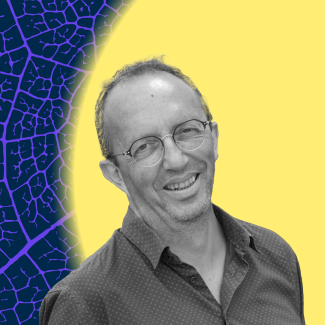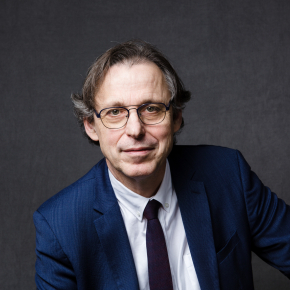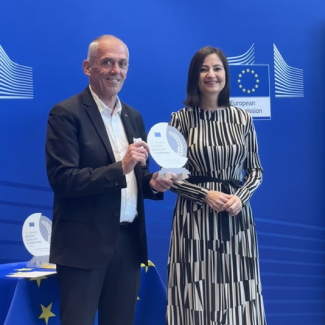
"The CNRS's six societal challenges have brought about appreciable change".
The implementation of the six societal challenges set out in the CNRS's Objectives and Performance Contract (COP) began in 2020. This work has promoted synergies between disciplines and created new research dynamics. Alain Schuhl, the Deputy CEO for Science, takes stock of this process now.
In 2019 for the first time the CNRS chose to include scientific challenges on topical subjects - climate change, educational inequalities, artificial intelligence, health and environment, territories of the future and energy transition - in its Objectives and Performance Contract (COP). What were the reasons behind this decision?
Alain Schuhl: Explicitly including societal challenges in the COP was new for the CNRS as compared with the previous COPs. It has brought about appreciable change because the CNRS's strength lies in fostering synergies between disciplines to help find answers to the questions society is asking which rarely involve just one discipline. The six challenges were therefore defined following suggestions from our ten Institutes from which we chose the most multidisciplinary ideas.
Would it be right to say the main objective of creating more synergies between disciplines has been achieved?
A.S.: Totally, yes. For our response to each challenge, everything began with a working group made up of representatives from the ten CNRS Institutes along with our Mission for Transversal and Interdisciplinary Initiatives (MITI). The fact that all these disciplines were involved in our approach to societal challenges meant we could focus on issues from new angles. Firstly, the working groups were able to develop original approaches and new content by drawing on the wealth of the CNRS's thousand plus joint research units. Regular interaction between the Institutes on scientific issues also led to more in-depth exchanges and fostered new dynamics. To give a few examples, the Educational Inequalities challenge (French link) helped us break down barriers within a community that was previously organised into silos and also to establish the confirmed relevance of interdisciplinary research into education. This was proved by the creation of the 'Research into educational issues' Research Network (GdR)1 in January 2024 and also by the interdisciplinary projects that resulted from the call for proposals funded in the framework of this challenge. Such projects are a clear sign that a fast-growing research field is being effectively structured. Another example with highly tangible results is the Artificial intelligence for science, science for artificial intelligence (AISSAI) centre. This is a multi-disciplinary centre dedicated to AI that resulted from work on the Artificial Intelligence challenge. The AISSAI centre has defined its positioning at the core of a dialogue on AI between all scientific disciplines that aims to push back the frontiers in all the sciences and thus speed up scientific discoveries - in the search for new molecular configurations for better medicines, in the sciences of the universe, the humanities and social sciences and so forth.
In 2021, the French government launched its France 2030 plan which featured a major research component with the Priority Research Programmes and Equipments (PEPRs). Some of the themes of these PEPRs are the same as those of the CNRS's challenges – AI for instance. How do these various initiatives interconnect in their functioning?
A.S.: The PEPRs are strategic investments for France and when they arrived on the scene the CNRS's societal challenges had already been launched. Most of the subjects covered by the PEPRs - from water as a common good, to climate, artificial intelligence and even education - are related to the CNRS's societal challenges. This proves the CNRS is right in its choice of themes and their importance for society and the country. Actually, the CNRS steers or co-steers two thirds of the PEPRs and all of the exploratory PEPRs. Of course the CNRS promotes transdisciplinarity which means we have been able to enrich and capitalise upon the existing foundation of our work on challenges of this kind.
A wide range of responses have emerged from work on these challenges – from a 'Workshop Zone' to a research centre, including the forthcoming GdRs. What is your overall assessment of this now?
A.S.: The challenges set out in the COP created a true dynamic which has underlined – if that was still necessary - the fact that the right responses to the major problems facing our societies right now and in the future require the involvement of several disciplines. The CNRS is one of the few places that brings these all together. In tangible terms, sixteen calls for projects or calls for expressions of interest have been launched. Some of the research would not have seen the light of day without the challenges existing and the various meetings they have led to, like conferences or workshops, have been a real success. For example, the 'Energy Transition and Society' seminar (French link) was held to work on the Energy Transition challenge and this created a true momentum for the future structuring of energy transition research the objective of which is to become a kind of "IPCC for energy". The health and environment challenge paved the way for the creation of the new Camargue 'Workshop Zone' (French link) which will study scenarios for the transfer of viruses from animals to humans, toxicology by pollutants and even eco-anxiety. These are a few tangible examples of achievements deriving from the CNRS's six societal challenges and I could mention more...
Work on all the challenges has also aimed for significant integration of society and its expectations into the development of the objectives involved.
A.S.: There has been a great deal of discussion about the relationship between fundamental research and its application to society throughout the work process on these challenges. How can common scientific questions be defined? How can we make it easier for the results to be appropriated? One example of a response is the 'Inhabitable Territories' joint laboratory project in the Marseille area (French link) created in the framework of the territories of the future challenge. The project aims to construct partnerships between local stakeholders and the CNRS so that both scientific production and social innovations drive the production of knowledge. As a structure, it facilitates the transition from research to political action in real terms.
How do these challenges fit with the CNRS's strategy for Europe and internationally?
A.S.: The fact that our societal challenges involve transversal issues means they have been given an important place in a number of international cooperation initiatives. One example is the CNRS's International Research Centre (IRC)2 , the 'France-Arizona Institute for Global Grand Challenges' (French link) (Tucson, USA). This centre was selected as one of the study sites for the health and environment challenge. The AISSAI centre is unique in the European research landscape and possesses a very high-level international scientific committee. The themes of the six challenges correspond effectively with those of our international and European partners which means we also benefit from support from many national and international research funding tools.
The CNRS's 2019-2023 COP is now coming to an end. What happens next?
A.S.: The initiatives launched will continue and live on. The objective of the six COP challenges was to drive dynamics to work on key issues. Have we covered everything concerning climate change, educational inequalities or artificial intelligence? Certainly not. For instance, in the framework of the climate change(French link) challenge, the creation of a 'Global Change' unit was proposed to coordinate CNRS activities linked to the study of global and environmental change and in supporting the transition, thus covering the IPCC's three pillars - the physical science basis of climate change, adaptation and mitigation. This unit's work dovetails well with the climate, biodiversity and sustainable programme agency the French government recently entrusted to the CNRS3 . This confirms the scientific coherence of taking work on the challenge further and justifies the CNRS collectively organising its work to deal with this issue effectively.
Moving forward with the idea of continuity, these challenges have enabled us to identify several thematic areas for support by the CNRS's Mission for Transversal and Interdisciplinary Initiatives4 . These are Territories: observatory and laboratory (and digital space); Sobriety and Resilience, Data, AI and Scenarios for the Future, Global Changes, Forcing and Transformations, Health - sport and physical activity – and Autonomy, Pollution (and waste) - remediation – the exposome.
Now that the COP is coming to an end, a new Contract of Objectives, Resources and Performance (COMP) is in the pipeline which will include six or seven transversal issues. Discussion is still ongoing on these but they should be announced in the summer.
- 1These Research Networks (GDRs) are created for a five-year period that can be renewed once. Their aim is to drive exchanges between CNRS researchers, academic partners, companies and other stakeholders.
- 2IRCs are recently created cooperation structures bringing together the CNRS and its main international partners.
- 3In his speech on December 7th 2023, Emmanuel Macron announced the creation of programme agencies. This represents a new challenge for national research organisations.
- 4The MITI's main objectives are to support interdisciplinary research programmes and transversal initiatives at the CNRS, to organise foresight conferences and to coordinate interdisciplinary professional and technology networks.


